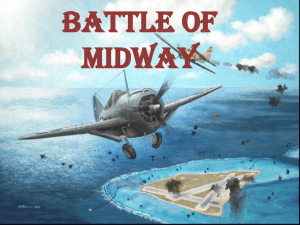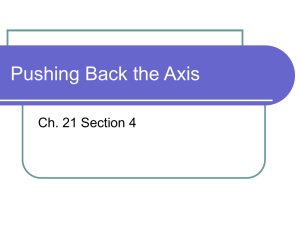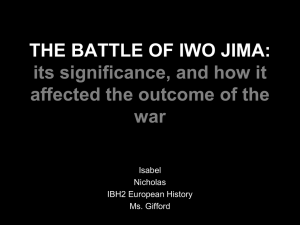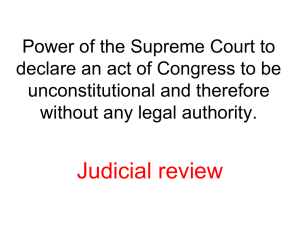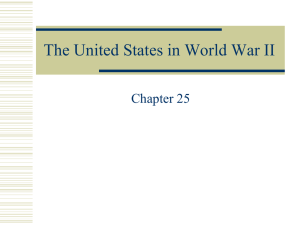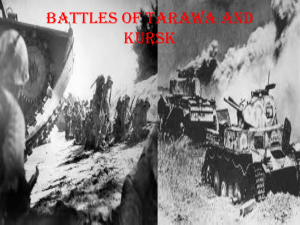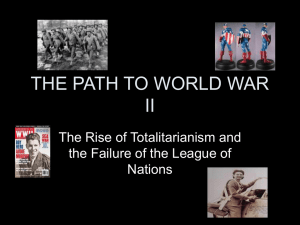click here to view my powerpoint!
advertisement
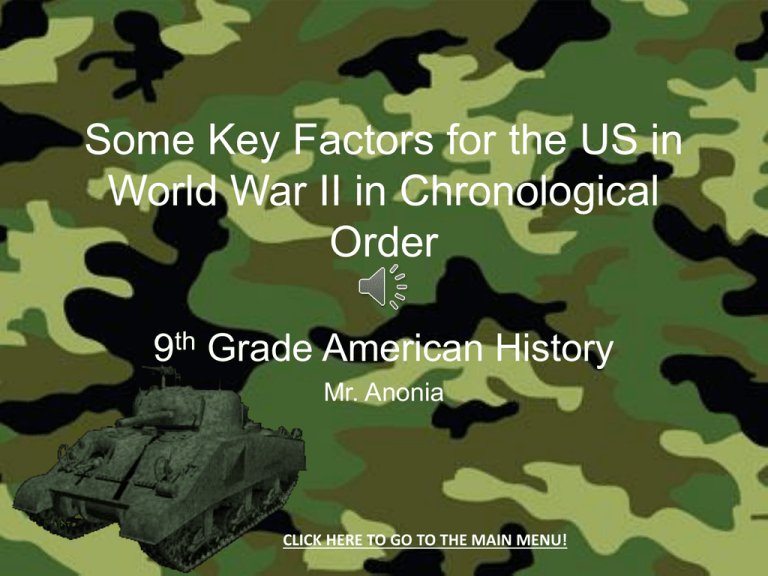
Some Key Factors for the US in World War II in Chronological Order 9th Grade American History Mr. Anonia CLICK HERE TO GO TO THE MAIN MENU! Main Menu December 7,1941 June 4-7, 1942 June 6, 1944 August 6 and 9, 1945 Attack on Pearl Harbor Battle of Midway Operation Overlord CLICK THE PICTURES TO LEARN ABOUT EACH BATTLE! Then click on the quiz after reviewing each slide! Operation Market Garden Battle of The Bulge Battle of Iwo Jima Dropping of the Atomic Bombs Click Here To Take The Quiz!!! September 17-25, 1944 Dec 16, 1944 – Jan 25, 1945 Feb 19, 1945 – Mar 26, 1945 Pearl Harbor Images going clockwise: (top left) A Japanese Zero leaving a aircraft carrier for the attack, (top right) Position of the US Navel fleet at Pearl, (bottom left) The USS Arizona memorial at Pearl Click Here to Continue Battle of Midway Images going clockwise: (top left) Art work depicting the battle at sea, (top right) The USS Yorktown on fire after being hit by a Japanese dive bomber, (bottom left) Art work depicting a US plan drop a torpedo at a Japanese carrier Click Here to Continue Operation Overlord Images going clockwise: (top left) Battle map of D-Day, (top right) A reenactment of the beach landings on D-Day, (bottom left) Paratroopers boarding their planes for the night jump Click Here to Continue Operation Market Garden Images going clockwise: (top left) A picture of Nijmegen bridge during the fighting (top right) The battle map of Operation Market Garden, (bottom right) Art work depicting paratroopers making the day jump during the operation Click Here to Continue Battle of The Bulge Images going clockwise: (top left) Paratroopers dug in at Bastogne, (top right) Battle map of the battle, (bottom left) Paratroopers holding the line Click Here to Continue Battle of Iwo Jima Images going clockwise: (top left) Marines under fire on the beach, (top right) Battle map of Iwo Jima, (bottom left) Marines celebrating after raising the flag on Mt. Suribachi Click Here to Continue The Dropping of the Atomic Bomb Images going clockwise: (top left) A picture of the Atomic bomb used on Nagasaki and Hiroshima, (top right) The aftermath of the using of the bombs, (bottom left) The Enola Gay was the first plane to drop a atomic bomb Click Here to Continue Click Here To Return To Main Menu Pearl Harbor Continued • • • • • • • • The Japanese lead a surprise attack at the US navel base in Pearl Harbor, Hawaii. The reason behind the attack was the US stopped trade and the shipment of oil to the Empire of Japan due to the Japanese invading China. The goal of the attack was to cripple the US navy. There were three waves of planes but the Japanese only sent two aerial attacks which consisted of about 360 planes that were launched from about six carriers. The result of the attack was 21 ships of the US Pacific fleet were destroyed or damaged, 188 planes were destroyed with 155 damaged, and 2,403 crew men and civilians killed with 1,178 crew men and civilians wounded. Admiral Yamamoto head of the Japanese navy said after the attack on Pearl Harbor was "I fear all we have done is to awaken a sleeping giant and fill him with a terrible resolve.“ The day after the attack President Roosevelt addressed congress asking to go to war with one the most famous speeches in US history “December 7, 1941 a date which will live in infamy.” Congress agreed for war and that sent us into World War II. On December 11, 1941 Germany and Italy then declared war on the United States. Click Here To Return To Main Menu Midway Continued • • • • • • • Six months after he battle of Pearl Harbor Admiral Yamamoto lead a force of four aircraft carriers, 2 battle ships, 15 support ships, around 250 carrier planes, 16 float planes, and about 180 other ships that did not participate in the battle tried to lure US aircraft carriers into a trap and try to have a control of Midway island and the Pacific. The US fleet lead by Admiral Nimitz was a lot smaller than the Japanese fleet with only 3 carriers, 25 support ships, around 230 carrier planes, around 130 planes on Midway island, and 28 other ships. At the beginning of the battle the Japanese had sent a force to soften up Midway with planes and bombers, American scout planes got saw this and Radio Midway to send planes. The Americans did but the Japanese had far better planes and took out a lot of US planes. The US then sent all planes from the carriers to attack the Japanese carriers that were caught off guard. As a result of the battle the Japanese had lost all 4 carriers, 1 cruiser, 15 support ships, all their planes, and a total of 3,057 men killed. For the US they only lost 1 carrier, 1 destroyer, 150 planes, and a total of 307 men killed. This was an important victory for the US navy. They had gained control of the Pacific and crippled the Japanese navy. Click Here To Return To Main Menu Operation Overlord Continued • • • • • • • Operation Overlord or D-Day was the massive Allied invasion of Europe commanded by Allied supreme commander General Dwight D. Eisenhower. The objective for D-Day was to land Allied troops in Europe mainly at Normandy, France. By doing this it would begin the long road to Berlin and have some sort of a hold in Europe. This would be considered the largest invasion force ever to be assembled. The first part of the invasion was the night before troops landed on the beaches, around 17,000 US and British paratroopers and glider units were to be dropped behind enemy lines and capture key points like bridges and roads for when the main force comes inland off the beaches. Also to destroy artillery positions that might fire upon the beach and give the main force a really hard time. Bombers and ships would soften the enemy coast so the main invasion force wont run into too much trouble when landing. With main invasion force 73,000 US troops landed on Omaha and Utah beaches, 61,715 British troops landed on Gold and Sword beaches, and 21,400 Canadians landed on Juno beach. The German concentrated strength in the area was only 10,000 troops but the Germans had very heavily fortified bunkers all along the Normandy coast which helped them hold off the invading Allies only for a little bit. The invasion was success with the Allies only having 12,000 casualties. The Germans had estimated between 4-9,000 casualties. Within five days over 300,000 troops, 50,000 vehicles, and 100,000 tons of supplies were on the beaches so the overall result of this invasion was very important towards the Allies winning the war. Click Here To Return To Main Menu Market Garden Continued • • • • • Operation Market Garden was the invasion of Holland and it was lead by British General Field Marshall Bernard Montgomery. The object was paratroopers from the US 101st and 82nd airborne divisions were to capture 4 bridges and 1st British airborne division was to capture the last bridge. This force would consist of 41,628 paratroopers the largest airborne operation in history. While the paratroopers held on to these bridges they would wait for armor support to arrive. Montgomery believed by doing this he would have troops over the Rhine river and into Germany and could end the war by Christmas. The British XXX armor Corps would travel up a small highway that reached all of these bridges and would support the paratroopers. But this operation did not go according to plan. The XXX Corps was being hit hard by the Germans. Another big factor was the Germans ended up blowing up one the first bridges so engineers had to build a new one in order for tanks to cross. This bought the Germans enough time to over run the 1st British airborne division position. The XXX Crops never made it to the last bridge. Operation Market Garden was a failure with the Allies having 15-17,000 casualties, and destroyed 88 tanks and 144 transport aircrafts. The German losses only consisted of 6-13,000 casualties, 30 tanks, and 159 aircraft destroyed. Click Here To Return To Main Menu Battle of The Bulge Continued • • • • • The last major German offense that took place in the Ardennes in Belgium, France, and Luxembourg to try and break through the British and American lines and splitting them in half. Then capture Antwerp and then proceed to encircle and destroy four Allied armies. This would force the Allies to sign a peace treaty. When the Germans launched this offensive the US sent the 101st airborne division consisting of 11,800 men to defend the small town of Bastogne in Belgium. Bastogne had seven major road ways that would help the Germans move their troops a lot faster and to capture Antwerp. The men of the 101st held onto the town for seven days surrounded and out numbered with low amount of supplies and dressed in non combat gear for cold climates during the coldest winter on record. General Patton knew that the 101st could not hold on much longer under those conditions so he decided to pull his 3rd Army off the front lines 100 miles to the south and march them up to Bastogne. Patton’s forces made the march and pushed back the Germans. After this the weather started to be less foggy and so Allied air attacks could go underway. With this and the Americans pushing the back the Germans were defeated. This would be the last time Germany would go on the offensive and the war would be soon be over in Europe. Click Here To Return To Main Menu Iwo Jima Continued • • • • Iwo Jima was the second to the last major battle of the Pacific theater. The objective was to capture the island because of the three airfields that were stationed on their. The airfield would be important place for bombers because Iwo Jima was in range for bombers to reach Japan and be able to make it back. The operation involved a beach landing by the US Marines. Before the landings the US bombed the island for three days straight. Then three Marine divisions would land on Iwo to fight against 20,000 Japanese soldiers. When the Marines took control of the beach there was an order to climb the quit volcanic mountain called Suribachi next to the beach and clear out Japanese inside or on top of the mountain. The Marines made the climb and on top of the mountain they were order to raise a fairly large American flag. Then one of the most famous pictures in US history was taken of the flag being raised which you can see on the pervious slide. Marines on the bottom of the hill automatically thought it was a sign of victory. The fighting continued for the next 35 days of harsh bloody combat. The US Marines lost around 7,000 men and the Japanese lost all of their men except for 216 men were taken prisoner. Click Here To Return To Main Menu Atomic Bombing Continued • • • • • • The end was near for Japan but the Japanese refused to surrender. Every single one of their islands had been conquered by the US. So the US had two options invade Japan which would be a long expensive process that would cost more soldiers lives in combat or drop nuclear bombs that the US developed under the Manhattan Project. President Truman decided that by dropping the bombs it would end the war with Japan with out having to invade the island nation. So on August 6, 1945 the bomb code named the “Little Boy” dropped by the plane called the Enola Gay onto the city of Hiroshima. Japan still did not want to surrender so three days later on the 9th the US dropped another bomb code named the “Fat Man” onto the city of Nagasaki. With so much destruction and death, Japan had no choice but to surrender. So on August 15, 1945 surrender and the second world war was over. Then on September 2, 1945 a peace signing took place in Tokyo Bay aboard the battleship USS Missouri between the two nations who have been at each others throats since 1941. After the war American became the worlds super power due to the fact that the main land was not effected at all by the war, the economy was booming, and the fact that we had nuclear weaponry. QUIZ!!! What operation could have ended the war by Christmas in Europe? A. B. C. D. Operation Overlord Operation Market Garden Battle of Midway Battle of the Bulge WRONG! Operation Overlord was the invasion of Europe in Normandy, France. CLICK HERE TO GO BACK AND DO IT AGAIN!!! CORRECT! CONGRADULATIONS YOU KNOW YOUR HISTORY, CLICK HERE TO GO BACK TO THE MAIN MENU!!! NOPE! The Battle of Midway took place in the Pacific. Remember the US navy crippled the Japanese navy. CLICK HERE TO GO BACK AND DO IT AGAIN!!! INCORRECT! The Battle of the Bulge did take place in the winter so I can not blame you for mixing this up with the right answer. I just hope this drill sergeant wont blame you. CLICK HERE TO GO BACK AND DO IT AGAIN!!!

